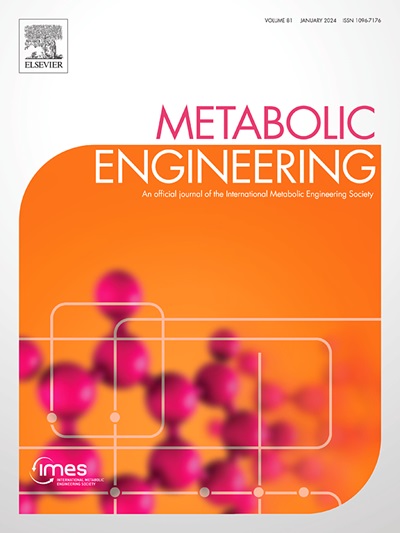Metabolic and enzyme rewiring enables high-production of vanillin in unconventional yeast.
IF 6.8
1区 生物学
Q1 BIOTECHNOLOGY & APPLIED MICROBIOLOGY
引用次数: 0
Abstract
Vanillin is an aromatic flavor compound widely used in the food, pharmaceutical, and cosmetic industries. Microbial biosynthesis offers a sustainable alternative to traditional plant extraction and chemical synthesis; however, the susceptibility of vanillin to redox reactions and the weak enzyme activity in cells severely limit the vanillin production capacity by microbial biosynthesis. This study presents the first successful attempt at de novo synthesis of vanillin in the unconventional yeast Komagataella phaffii. The initial titer was quite low (0.5 mg/L), but removal of 14 endogenous oxidoreductases to block vanillin conversion resulted in an 11.1-fold improvement in vanillin production. The combination of pathway rewiring and cofactor (nicotinamide adenine dinucleotide phosphate [NADPH] and S-adenosylmethionine) regeneration redirected the metabolic flux toward vanillin synthesis and achieved a further 19.9-fold improvement in vanillin production. Rational rewiring of the rate-limiting enzyme, caffeic acid O-methyltransferase (NtCOMT), generated a dominant mutant NtCOMTN312A/H315N from 70 variants, which promoted activity by 49.7% and prevented intermediate accumulation. These strategies eventually enabled the co-coupling of de novo biosynthesis and caffeic acid conversion, achieving the highest reported production of vanillin (1055.9 mg/L) by K. phaffii fermentation in a bioreactor. These findings highlight the potential of unconventional yeast as a chassis host for aromatic aldehyde synthesis and the construction of a versatile microbial platform for the production of carbonyl compounds.代谢和酶重组使非常规酵母的香兰素高产成为可能。
香兰素是一种芳香香料化合物,广泛应用于食品、制药和化妆品行业。微生物生物合成为传统的植物提取和化学合成提供了可持续的替代方案;然而,由于香兰素对氧化还原反应的敏感性和细胞内酶活性较弱,严重限制了微生物合成香兰素的生产能力。本研究首次成功尝试在非常规酵母法菲酵母中重新合成香兰素。初始滴度很低(0.5 mg/L),但去除14个内源性氧化还原酶以阻断香兰素转化,使香兰素产量提高了11.1倍。途径重组和辅助因子(烟酰胺腺嘌呤二核苷酸磷酸[NADPH]和s -腺苷蛋氨酸)再生的结合将代谢通量转向香兰素合成,并使香兰素产量进一步提高19.9倍。通过对限速酶咖啡酸o -甲基转移酶(NtCOMT)的合理重新连接,从70个突变体中产生了显性突变体NtCOMTN312A/H315N,其活性提高了49.7%,并阻止了中间积累。这些策略最终实现了新生物合成和咖啡酸转化的共偶联,在生物反应器中通过K. phaffii发酵实现了最高的香兰素产量(1055.9 mg/L)。这些发现突出了非传统酵母作为芳香醛合成的基础宿主和构建生产羰基化合物的多功能微生物平台的潜力。
本文章由计算机程序翻译,如有差异,请以英文原文为准。
求助全文
约1分钟内获得全文
求助全文
来源期刊

Metabolic engineering
工程技术-生物工程与应用微生物
CiteScore
15.60
自引率
6.00%
发文量
140
审稿时长
44 days
期刊介绍:
Metabolic Engineering (MBE) is a journal that focuses on publishing original research papers on the directed modulation of metabolic pathways for metabolite overproduction or the enhancement of cellular properties. It welcomes papers that describe the engineering of native pathways and the synthesis of heterologous pathways to convert microorganisms into microbial cell factories. The journal covers experimental, computational, and modeling approaches for understanding metabolic pathways and manipulating them through genetic, media, or environmental means. Effective exploration of metabolic pathways necessitates the use of molecular biology and biochemistry methods, as well as engineering techniques for modeling and data analysis. MBE serves as a platform for interdisciplinary research in fields such as biochemistry, molecular biology, applied microbiology, cellular physiology, cellular nutrition in health and disease, and biochemical engineering. The journal publishes various types of papers, including original research papers and review papers. It is indexed and abstracted in databases such as Scopus, Embase, EMBiology, Current Contents - Life Sciences and Clinical Medicine, Science Citation Index, PubMed/Medline, CAS and Biotechnology Citation Index.
 求助内容:
求助内容: 应助结果提醒方式:
应助结果提醒方式:


